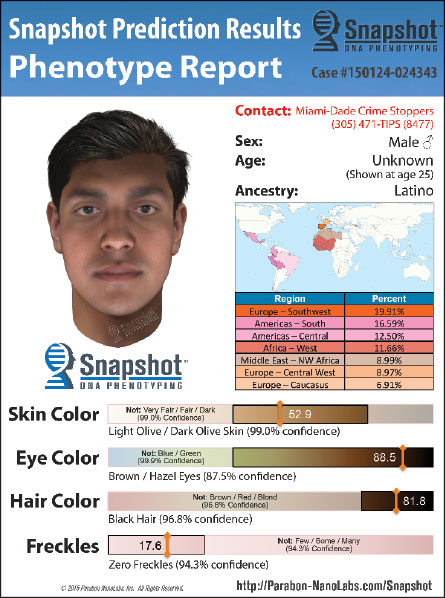Police use discarded chewing gum to figure out what a suspect looks like
Genetic scraps of evidence from material such as chewing gum are helping police to unmask the faces of criminals who their victims have never seen.
Genetic scraps of evidence from material such as chewing gum are helping police to unmask the faces of criminals who their victims have never seen.
Thanks to discarded bits of DNA left behind by suspects, a genetics company is piecing together the digital likenesses of offenders.
Police in Florida have turned to science in the search for a man who has terrorised at least a dozen women over the last two years.
The suspect has been peeping into windows and slipping into bedrooms to watch his victims sleep. He has touched several womens feet or hair and some, he has sexually assaulted.
Dubbed the Serial Creeper, the Miami police are desperate to find him.
They have released this sketch of a dark-haired, dark-eyed Latino man with smooth skin, high cheekbones and a pointed chin.
But the impression was not drawn by a police artist based on eyewitness accounts. The Creeper has kept his face covered in every assault, Florida police spokesperson Kelly Denham told Science News. Hes never been seen.
So local police had to pursue a less-conventional route. They bought a computer-generated image based on the Creepers DNA.
They paid genetics company Parabon NanoLads £3,500 to analyse the DNA the Creeper left behind to mash-up a likeness of the Creepers face.
The images Parabon create do not offer an exact picture of a suspect, says Ellen Greytak, the companys bioinformatics director.
We work with law enforcement agencies to give them an idea of who they should be looking for, she said or more especially which people to cross off the suspect list.
This isn`t the first time the company has used genetic scraps to create images of stranger`s faces.
Back in May, it teamed up with a Hong Kong advertising agency to shame local litter louts for polluting the streets.
Using the DNA left behind on chewing gum and cigarettes, Parabon zeroed-in on genes that code for physical traits like hair and eye colour. Then, they drafted computer-generated sketches of each polluter`s face, printed them out on giant wanted posters, and pasted them on billboards throughout the city
The science behind the idea of using DNA to predict a face has existed for years.
In 2012, New York City-based artist Heather Dewey-Hagborg used the same technology to make sculptures of complete strangers using only the tiny bits of DNA left on discarded cigarettes and chewing gum that she collected from the streets of New York.
Each piece of rubbish that Ms Dewey-Hagborg collected was rich in genetic data, typically in the form of DNA encased in dried spit or inside pieces of hair and skin.
To isolate that DNA, she conducted a simple laboratory procedure. Then, using a computer programme, she combed through all the DNA and picked out only the genes that code for physical traits, like hair and eye colour.
Her exhibit, called “Stranger Visions,” has been shown in galleries across the world.
In addition to hair and eye colour, these bits of our DNA dictate the shade of our skin, the width of our noses and the distance between our eyes, but they cannot tell how old or physically fit a person is.
It is the same rule that applies to the images Parabon create.
As vague as it is, a general idea is all the current science can guarantee. That is because each of us has three billion chemical base pairs of DNA that altogether make us who we are, says Parabon.
One method of analysing all of these genes is looking at evidence linked to specific traits like hair and eye colour, susceptibility to certain diseases, and ancestry. This method of DNA analysis is called SNP (pronounced “snip”) sequencing.
The technique is far better at predicting certain traits than others. Scientists can use it to predict blue and brown eye colour and red hair colour, for example, with pretty striking accuracy. But blonde hair is much trickier, and things like height and face shape are another matter entirely.
Its a hazy place, the scientists agree, where the roots of a persons looks hide out in thei


